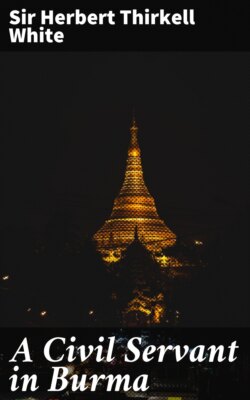A Civil Servant in Burma

Реклама. ООО «ЛитРес», ИНН: 7719571260.
Оглавление
Sir Herbert Thirkell White. A Civil Servant in Burma
A Civil Servant in Burma
Table of Contents
PREFACE
NOTE
ERRATUM
A CIVIL SERVANT IN BURMA
CHAPTER I. INTRODUCTORY: A RETROSPECT AND SOME COMPARISONS
CHAPTER II. EARLY YEARS AND FIRST IMPRESSIONS
CHAPTER III. THE FIRST SUBDIVISION: THE SECRETARIAT
CHAPTER IV. SOME ASPECTS OF BURMESE LIFE AND CHARACTER
CHAPTER V. ON THE FRONTIER
CHAPTER VI. THE SECRETARIAT: THE LAST SUBDIVISION
CHAPTER VII. THE TAKING OF MANDALAY
CHAPTER VIII. EARLY DAYS AT MANDALAY
CHAPTER IX. LORD DUFFERIN’S VISIT: MANDALAY ONCE MORE
CHAPTER X. THE FIRST YEAR AFTER THE ANNEXATION
CHAPTER XI. A FEW WORDS ON BUDDHISM
CHAPTER XII. UNDER SIR CHARLES CROSTHWAITE, 1887–1890
CHAPTER XIII. A VISIT TO THE SHAN STATES
CHAPTER XIV. RANGOON—MANDALAY
CHAPTER XV. LOWER BURMA ONCE MORE
CHAPTER XVI. MANDALAY—THE BOUNDARY COMMISSION
CHAPTER XVII. THE CHIEF COURT—LAST YEARS IN BURMA
GLOSSARY
FOOTNOTES:
INDEX
Отрывок из книги
Sir Herbert Thirkell White
Published by Good Press, 2019
.....
The garrison consisted of two battalions of British infantry, one of which gave a detachment to the Andamans, five Madras regiments, and five batteries of artillery. Troops were stationed at Rangoon, on the frontier at Toungoo and Thayet-myo, and at Moulmein. There were no troops in Arakan. There were no military police. The Province was in a state of profound peace, though there were occasional dacoities on the borders, and, as always, Tharrawaddy had a bad name.
Of Rangoon in those early days, separate mention may be made. One glory it had which still abides. The Shwe Dagôn Pagoda, most sacred and most illustrious of pure Buddhist shrines, dominating the landscape, rose golden to the sky. From far the traveller approaching Rangoon from the sea caught sight of that amazing shaft of gold, and instinctively did reverence. In the bright winter sunshine, in the blue haze of summer heat, in the veiled mysteries of tropic moonlight, it towered awe-inspiring, stupendous, divine. On feast days and sabbaths the platform was thronged with worshippers, surely the brightest, best-humoured, most laughter-loving of all pious crowds. Even now one can imagine no scene more gracious, more mystically serene and lovely, than the pagoda in the light of the full moon, when all that is tawdry and unseemly is charmed away. But thirty years ago, before the platform was covered with modern shrines not all in harmony with æsthetic canons, it was still more gravely and austerely beautiful.
.....